Advanced Various Fault Detection Scheme for Long-Reach Mode Division Multiplexing Transmission
Abstract
:1. Introduction
2. Operating Principle
3. Theoretical Analysis of Localization Accuracy of Various Faults
3.1. Few Mode Fiber Break
3.2. Few Mode Fiber Link Connector Mismatch
3.3. Few Mode Fiber Bending
4. Analysis of the Localization Accuracy
4.1. Error Analysis of Few-Mode Fiber Break
4.2. Error Analysis of Few-Mode Fiber Link Connector Mismatch
4.3. Error Analysis of Few-Mode Fiber Bending
5. Further Discussion and Conclusions
6. Conclusions
Author Contributions
Funding
Institutional Review Board Statement
Informed Consent Statement
Data Availability Statement
Conflicts of Interest
References
- Rademacher, G.; Puttnam, B.J.; Luís, R.S.; Sakaguchi, J.; Klaus, W.; Eriksson, T.A.; Awaji, Y.; Hayashi, T.; Nagashima, T.; Nakanishi, T.; et al. 10.66 Peta-Bit/s Transmission over a 38-Core-Three-Mode Fiber. In Proceedings of the Optical Fiber Communication Conference, San Diego, CA, USA, 8–12 March 2020; Optical Society of America: Washington, DC, USA, 2020. Th3H.1. [Google Scholar]
- Puttnam, B.J.; Rademacher, G.; Luís, R.S. Space-division multiplexing for optical fiber communications. Optica 2021, 8, 1186–1203. [Google Scholar] [CrossRef]
- Li, G.; Bai, N.; Zhao, N.; Xia, C. Space-division multiplexing: The next frontier in optical communication. Adv. Opt. Photonics 2014, 6, 413–487. [Google Scholar] [CrossRef]
- Winzer, P.J. Making spatial multiplexing a reality. Nat. Photonics 2014, 8, 345–348. [Google Scholar] [CrossRef]
- Zuo, M.; Ge, D.; Liu, J.; Gao, Y.; Shen, L.; Lan, X.; Chen, Z.; He, Y.; Li, J. Long-haul intermodal-MIMO-free MDM transmission based on a weakly coupled multiple-ring-core few-mode fiber. Opt. Express 2022, 30, 5868–5878. [Google Scholar] [CrossRef]
- Soma, D.; Beppu, S.; Yoshikane, N.; Tsuritani, T. High-Capacity Mode Division Multiplexing Transmission Technology. In Proceedings of the Optical Fiber Communication Conference, San Diego, CA, USA, 6–10 March 2022; Optical Society of America: Washington, DC, USA, 2022. M4B.2. [Google Scholar]
- Zhang, M.; Wang, Y. Review on Chaotic Lasers and Measurement Applications. J. Light. Technol. 2021, 39, 3711–3723. [Google Scholar] [CrossRef]
- Lu, L.; Song, Y.; Zhang, X.; Zhu, F. Frequency division multiplexing OTDR with fast signal processing. Opt. Laser Technol. 2012, 44, 2206–2209. [Google Scholar] [CrossRef]
- Li, B.; Deng, G.; Zhang, R.; Ou, Z.; Zhou, H.; Ling, Y.; Wang, Y.; Wang, Y.; Qiu, K.; Song, H.; et al. High Dynamic Range Externally Time-Gated Photon Counting Optical Time-Domain Reflectometry. J. Light. Technol. 2019, 37, 5899–5906. [Google Scholar] [CrossRef]
- Liao, R.L.; Tang, M.; Zhao, C.; Wu, H.; Fu, S.N.; Liu, D.M.; Shum, P.P. Harnessing oversampling in correlation-coded OTDR. Opt. Express 2019, 27, 1693–1705. [Google Scholar] [CrossRef]
- Wang, S.; Fan, X.Y.; He, Z.Y. Ultra-high resolution Optical Reflectometry based on Linear Optical Sampling Technique with Digital Dispersion Compensation. IEEE Photonics J. 2017, 9, 6804710. [Google Scholar] [CrossRef]
- Xiong, J.; Wang, Z.N.; Wu, Y.; Rao, Y.J. Single-Shot COTDR Using Sub-Chirped-Pulse Extraction Algorithm for Distributed Strain Sensing. J. Light. Technol. 2020, 38, 2028–2036. [Google Scholar] [CrossRef]
- Fernández, M.P.; Bulus Rossini, L.A.; Pascual, J.P.; Costanzo Caso, P.A. Enhanced fault characterization by using a conventional OTDR and DSP techniques. Opt. Express 2018, 26, 27127–27140. [Google Scholar] [CrossRef] [PubMed]
- Von Der Weid, J.P.; Souto, M.H.; Garcia, J.D.; Amaral, G.C. Adaptive Filter for Automatic Identification of Multiple Faults in a Noisy OTDR Profile. J. Light. Technol. 2016, 34, 3418–3424. [Google Scholar] [CrossRef]
- Nakazawa, M.; Yoshida, M.; Hirooka, T. Measurement of mode coupling distribution along a few-mode fiber using a synchronous multi-channel OTDR. Opt. Express 2014, 22, 31299–31309. [Google Scholar] [CrossRef]
- Badar, M.; Lu, P.; Buric, M.; Ohodnicki, P. Integrated Auxiliary Interferometer for Self-Correction of Nonlinear Tuning in Optical Frequency Domain Reflectometry. J. Light. Technol. 2020, 38, 6097–6103. [Google Scholar] [CrossRef]
- Zhang, Z.P.; Fan, X.Y.; Wu, M.S.; He, Z.Y. Phase-Noise-Compensated OFDR Realized Using Hardware-Adaptive Algorithm for Real-Time Processing. J. Light. Technol. 2019, 37, 2634–2640. [Google Scholar] [CrossRef]
- Abdelli, K.; Cho, J.Y.; Azendorf, F.; Griesser, H.; Tropschug, C.; Pachnicke, S. Machine-learning-based anomaly detection in optical fiber monitoring. J. Opt. Commun. Netw. 2022, 14, 365–375. [Google Scholar] [CrossRef]
- Cen, M.; Chen, J.J.; Moeyaert, V.; Megret, P.; Wuilpart, M. Advanced Fault-Monitoring Scheme for Ring-Based Long-Reach Optical Access Networks. J. Light. Technol. 2017, 35, 1876–1885. [Google Scholar] [CrossRef]
- Song, C.; Liu, X.; Liu, F.; Zhang, M.; Hu, G. Fault detection of few-mode fiber based on high-order mode with high fault detection sensitivity. Opt. Lett. 2019, 44, 4487–4490. [Google Scholar] [CrossRef]
- Liu, F.; Zhang, W.; Wu, P.; He, Z. Fault detection sensitivity enhancement based on high-order spatial mode trend filtering for few-mode fiber link. Opt. Express 2021, 29, 5226–5235. [Google Scholar] [CrossRef]
- Yu, D.; Fu, S.; Cao, Z.; Tang, M.; Liu, D.; Giles, I.; Koonen, T.; Okonkwo, C. Mode-dependent characterization of photonic lanterns. Opt. Lett. 2016, 41, 2302–2305. [Google Scholar] [CrossRef]
- Liu, F.; Hu, G.; Song, C.; Chen, W.; Chen, C.; Chen, J. Simultaneous measurement of mode dependent loss and mode coupling in few mode fibers by analyzing the Rayleigh backscattering amplitudes. Appl. Opt. 2018, 57, 8894–8902. [Google Scholar] [CrossRef] [PubMed]
- Boffi, P.; Sambo, N.; Martell, P.; Parolari, P.; Gatto, A.; Cugini, F.; Castoldi, P. Mode-Group Division Multiplexing: Transmission, Node Architecture, and Provisioning. J. Light. Technol. 2022, 40, 2378–2389. [Google Scholar] [CrossRef]
- Cen, M.; Chen, J.J.; Moeyaert, V.; Megret, P.; Wuilpart, M. Full monitoring for long-reach TWDM passive optical networks. Opt. Express 2016, 24, 15782–15797. [Google Scholar] [CrossRef] [PubMed]

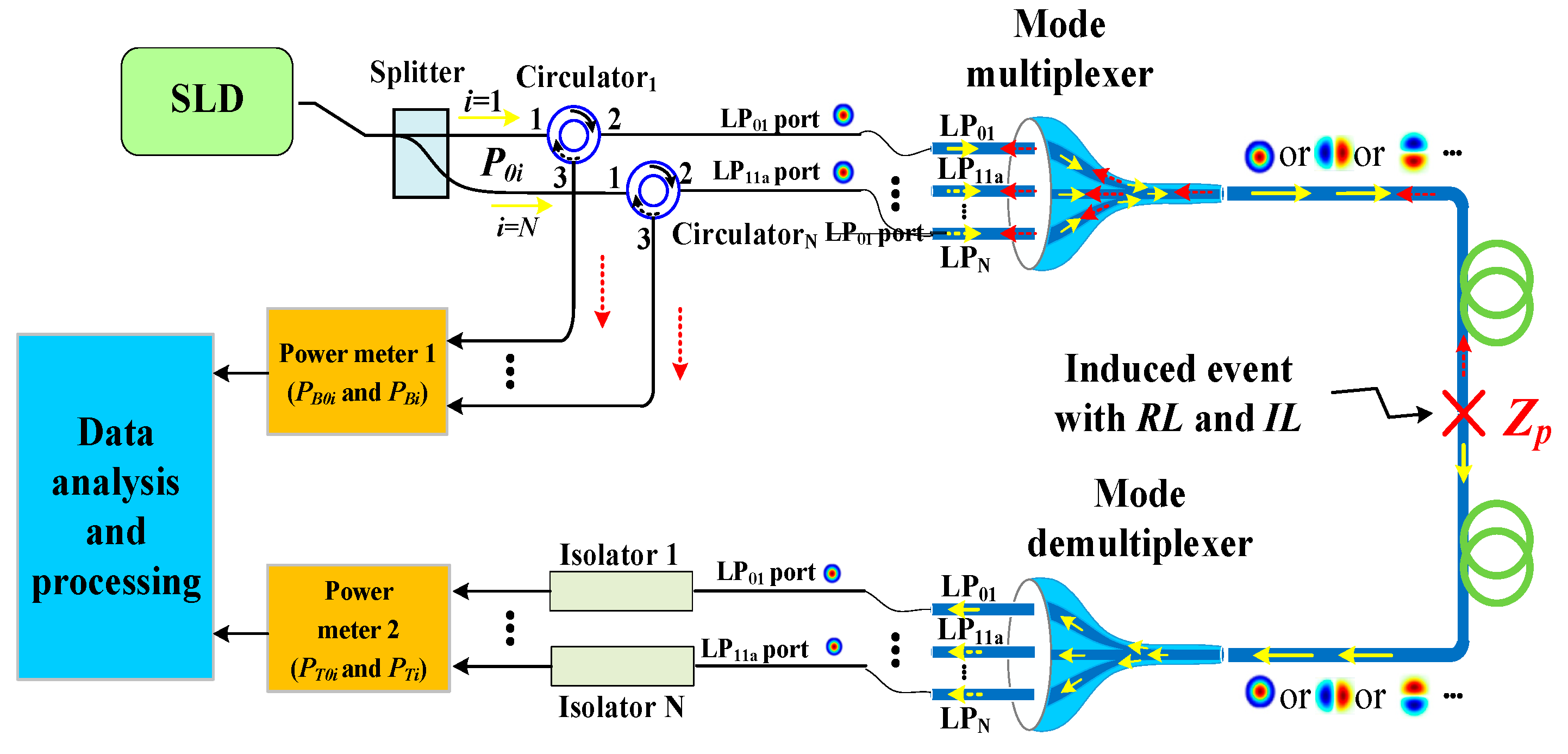
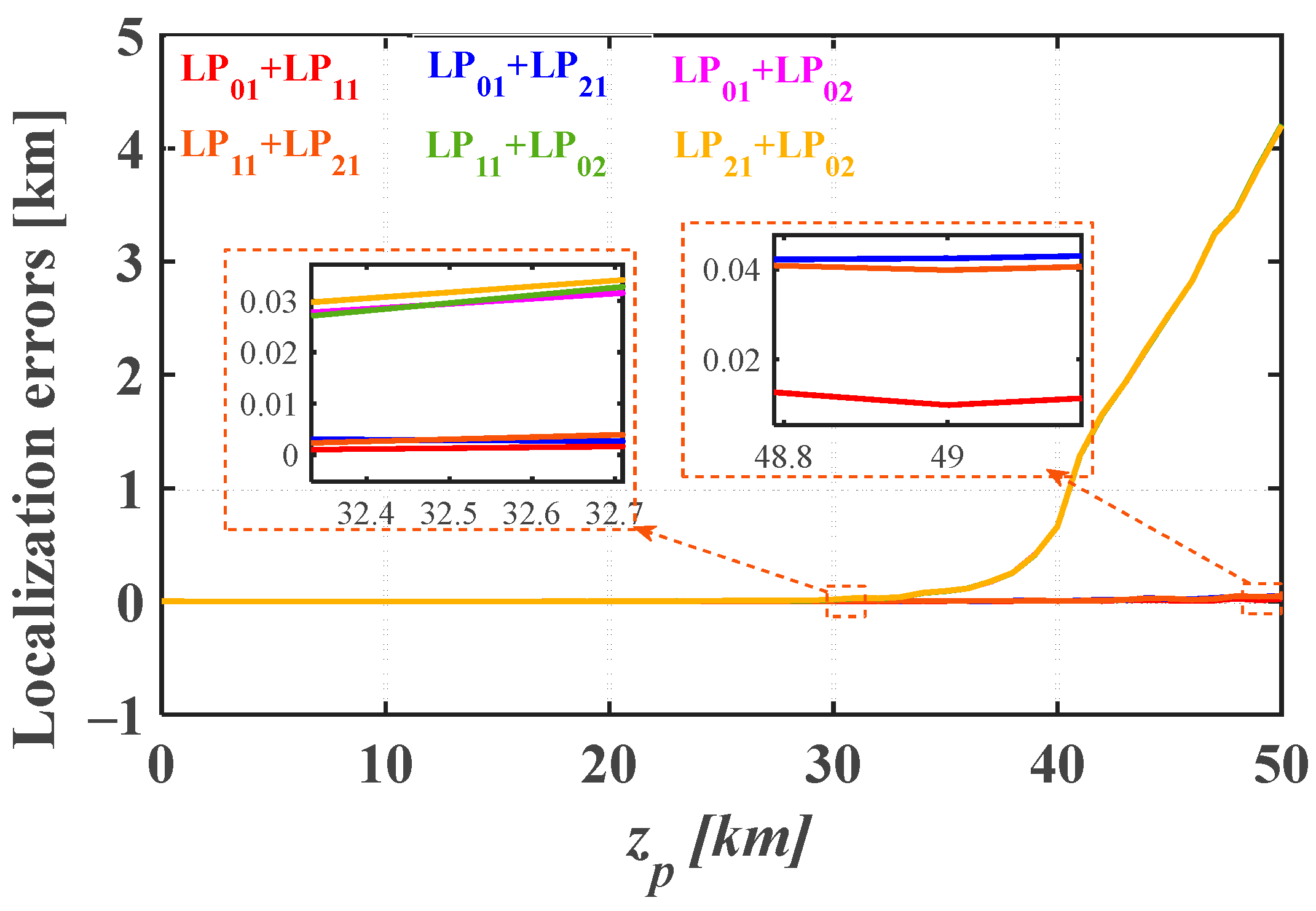
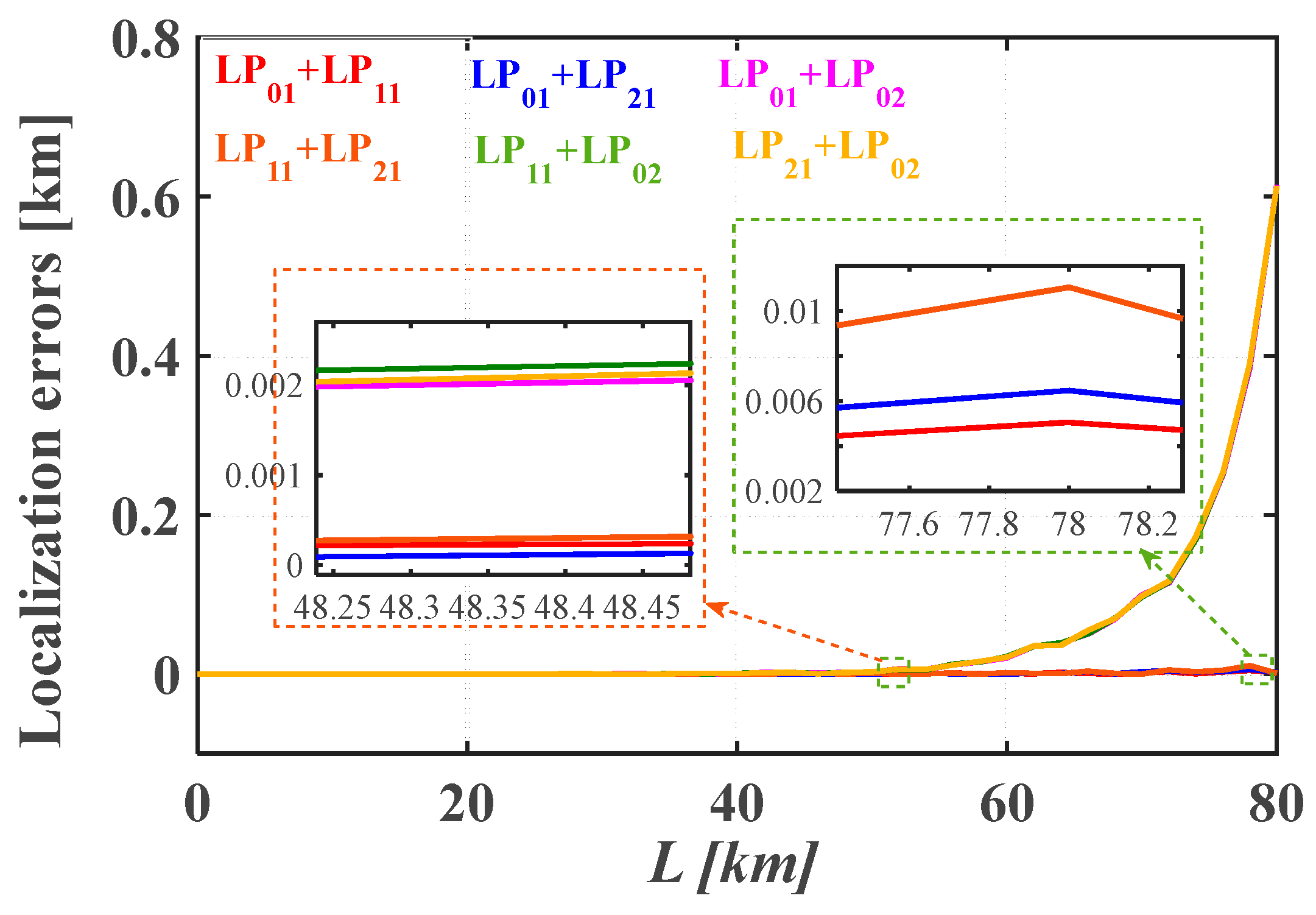




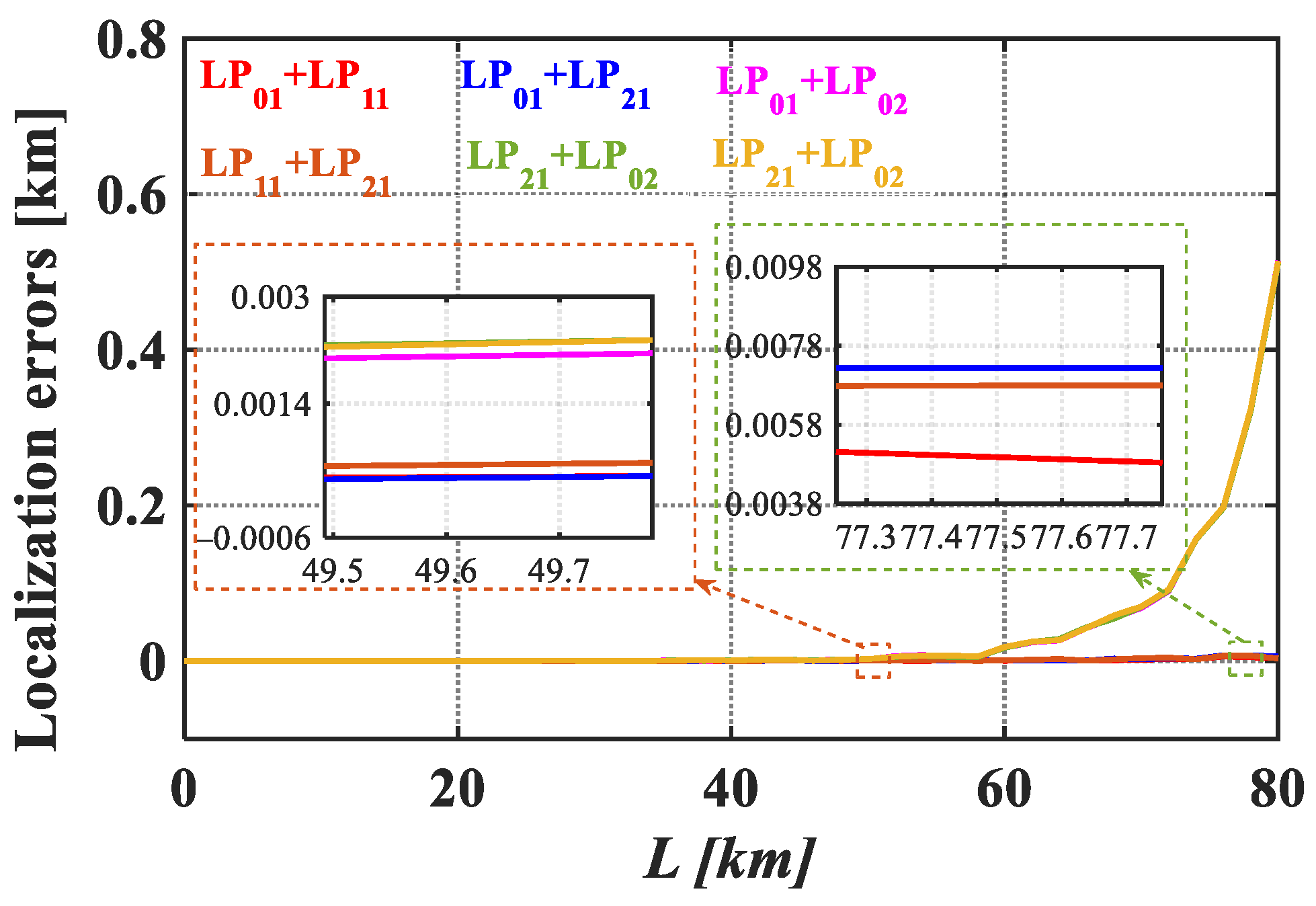
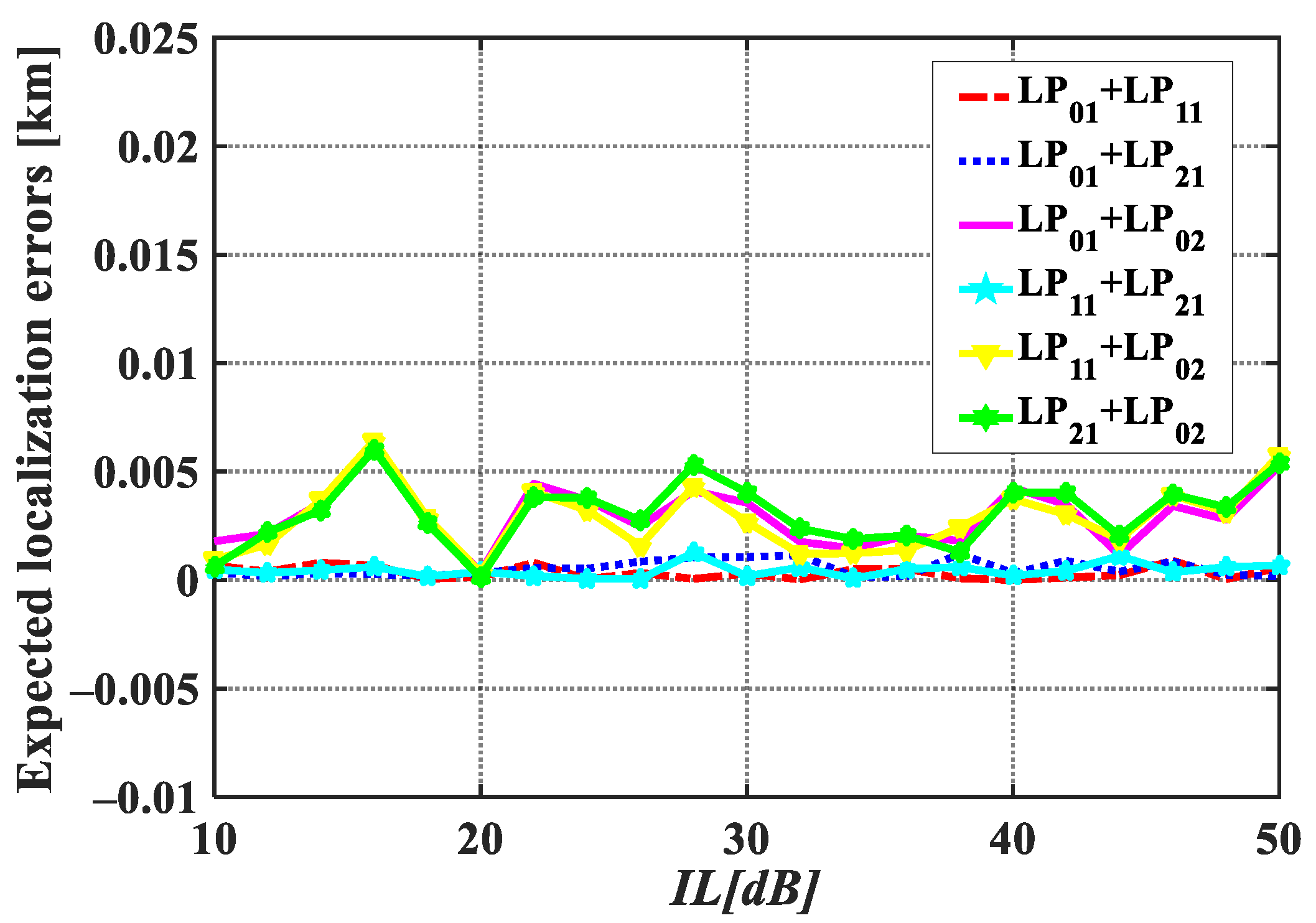

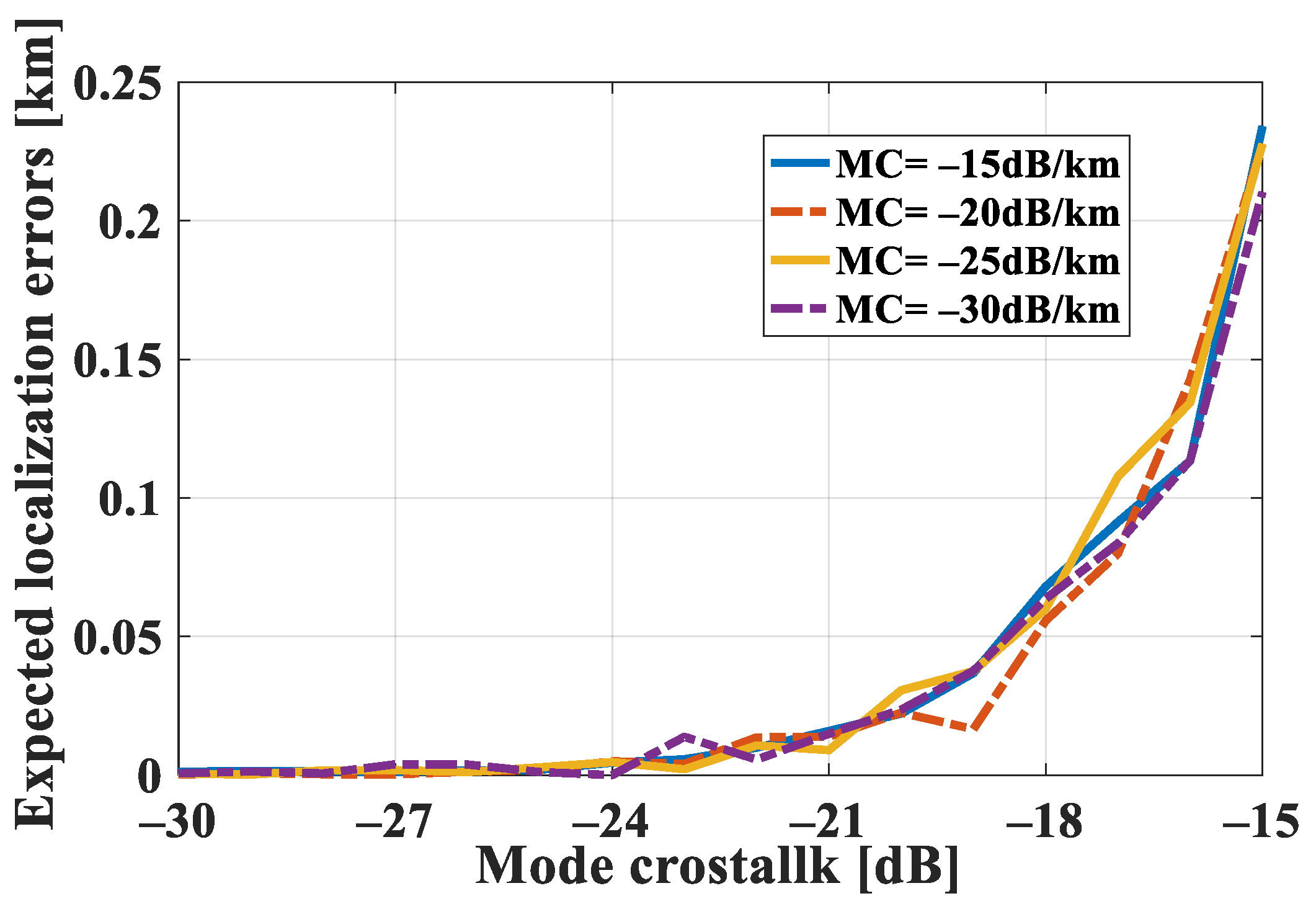

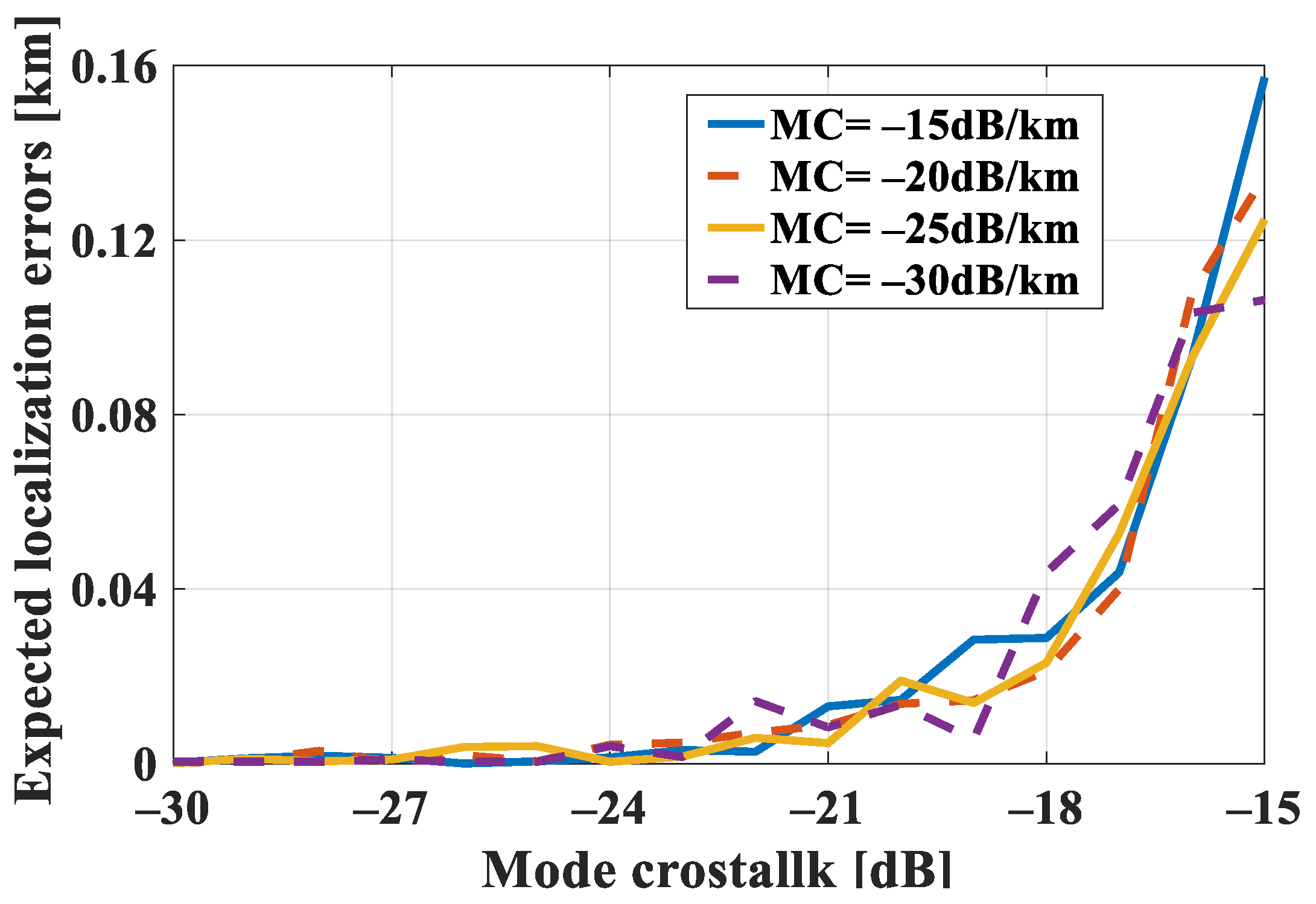
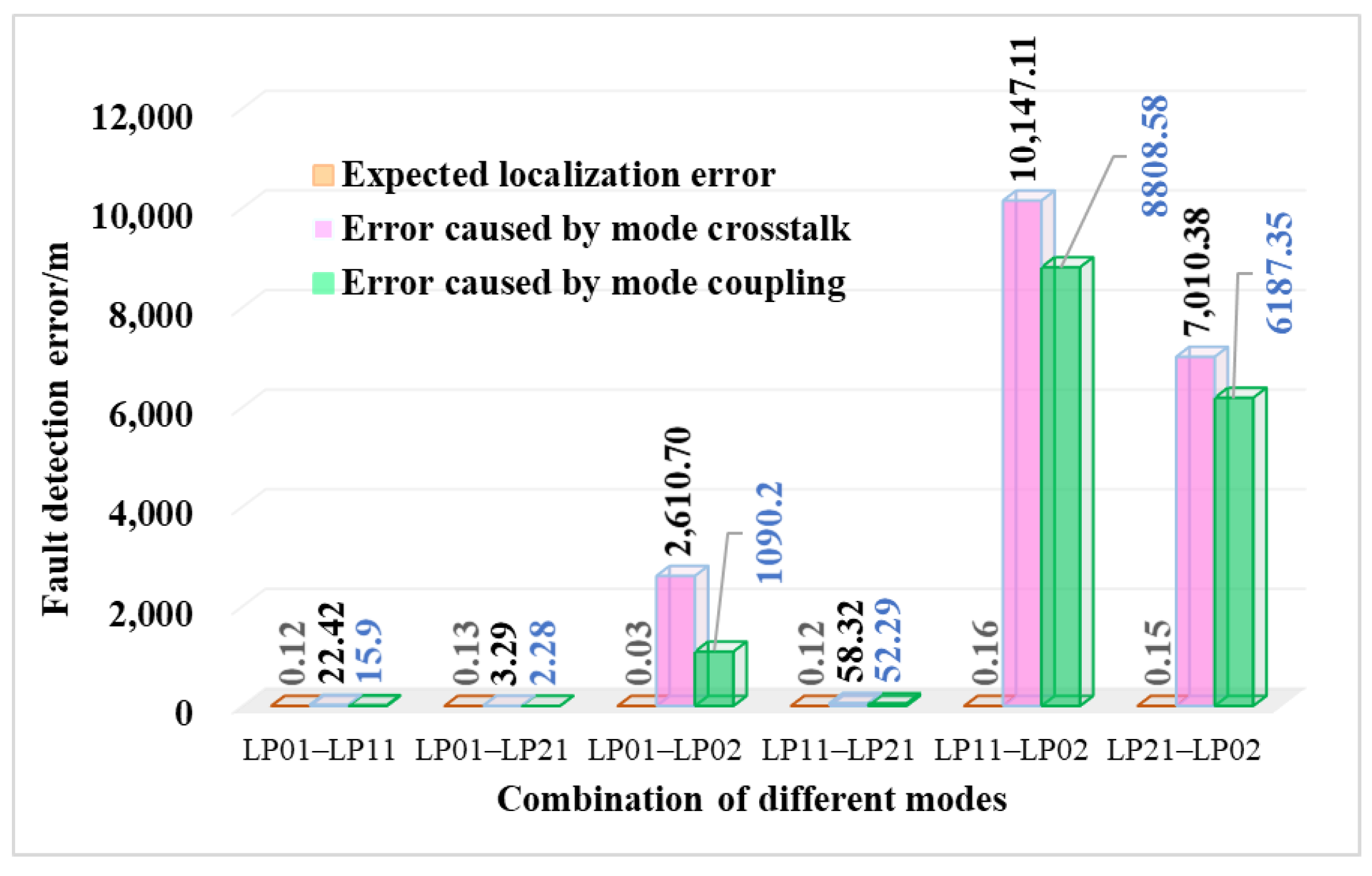
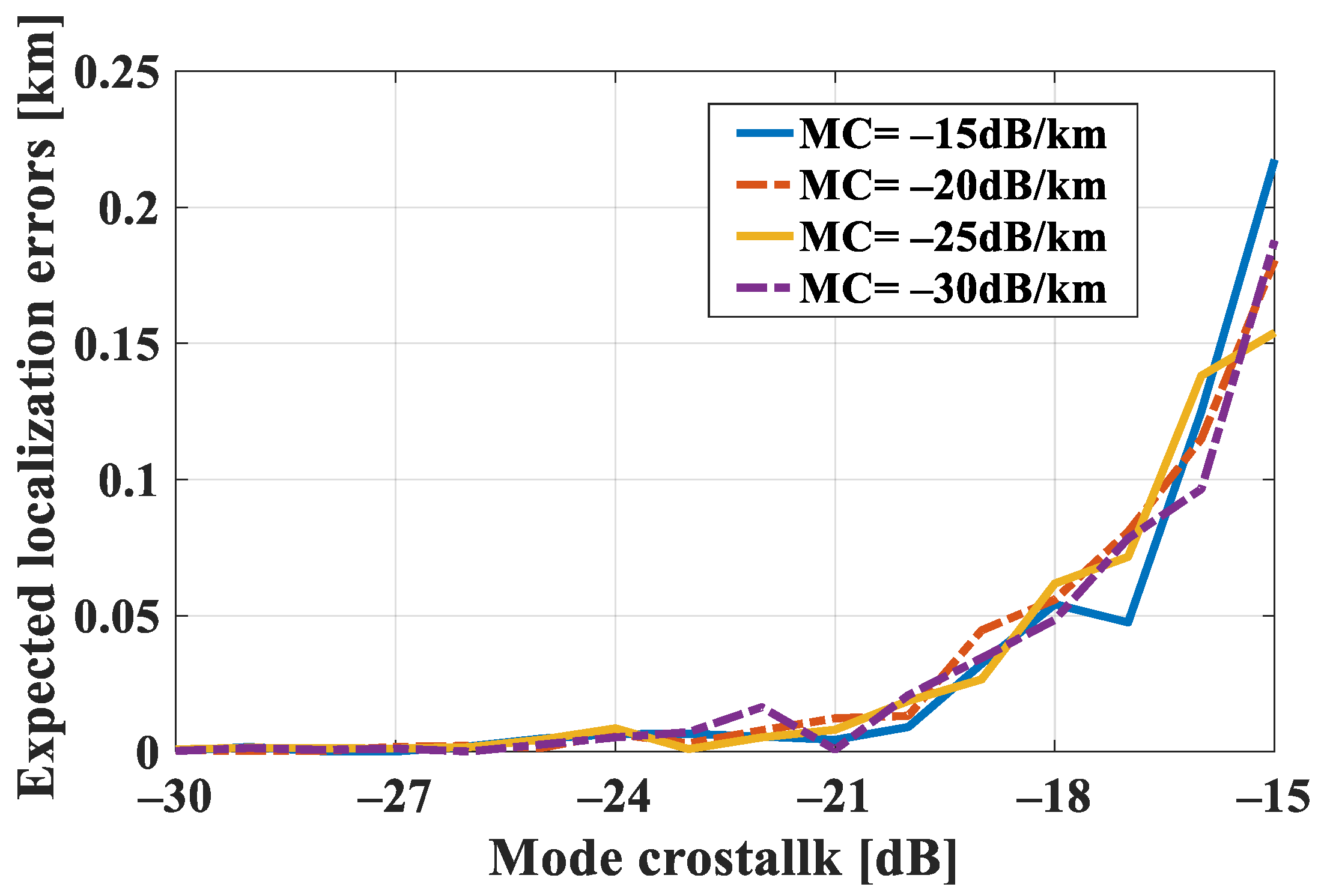
| Parameters | ||||||
|---|---|---|---|---|---|---|
| Value | 0.169 dB/km | 60 dB | 65 dB | 50 km | 0.332 dB | 0.461 dB |
| IL(dB) | MUX | DEMUX | |
|---|---|---|---|
| Mode | |||
| LP01 | 5.467 | 1.176 | |
| LP11 | 1.872 | 1.686 | |
| LP21 | 3.172 | 3.084 | |
| LP02 | 8.894 | 4.390 | |
| Modes | Mode Crosstalk [dB] | Mode Coupling [dB/km] |
|---|---|---|
| LP01--LP11 | −18.85 | −23.43 |
| LP01--LP21 | −27.91 | −26.43 |
| LP01--LP02 | −24.94 | −20.21 |
| LP11--LP21 | −17.18 | −19.44 |
| LP11--LP02 | −19 | −21.31 |
| LP21--LP02 | −20.81 | −18.64 |
| Our Proposed Method | OTDR | |
|---|---|---|
| Detection sensitivity | Better than 0.1 dB by high-order mode | Invalid detection by LP01 |
| Spatial resolution (m) | 1~15 for most cases, 61.5 for events using LP21 and LP02 | 10–30 |
| Measure time | 1~2 s (100 km) | >1 min (100 km) |
| Light source | Non-modulation continuous light | Modulated optical pulse |
| Dynamic range | Improved by increasing the input power | <50 dB |
| Multiple events detection | No | Yes |
| Double-ended measurement | Yes | No |
Disclaimer/Publisher’s Note: The statements, opinions and data contained in all publications are solely those of the individual author(s) and contributor(s) and not of MDPI and/or the editor(s). MDPI and/or the editor(s) disclaim responsibility for any injury to people or property resulting from any ideas, methods, instructions or products referred to in the content. |
© 2024 by the authors. Licensee MDPI, Basel, Switzerland. This article is an open access article distributed under the terms and conditions of the Creative Commons Attribution (CC BY) license (https://creativecommons.org/licenses/by/4.0/).
Share and Cite
Liu, F.; Huang, Z.; Gu, T. Advanced Various Fault Detection Scheme for Long-Reach Mode Division Multiplexing Transmission. Photonics 2024, 11, 523. https://doi.org/10.3390/photonics11060523
Liu F, Huang Z, Gu T. Advanced Various Fault Detection Scheme for Long-Reach Mode Division Multiplexing Transmission. Photonics. 2024; 11(6):523. https://doi.org/10.3390/photonics11060523
Chicago/Turabian StyleLiu, Feng, Zicheng Huang, and Tianle Gu. 2024. "Advanced Various Fault Detection Scheme for Long-Reach Mode Division Multiplexing Transmission" Photonics 11, no. 6: 523. https://doi.org/10.3390/photonics11060523





